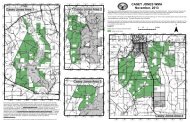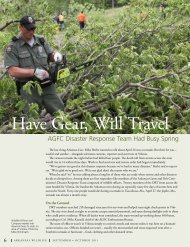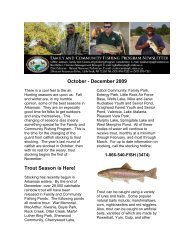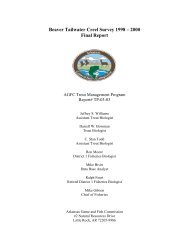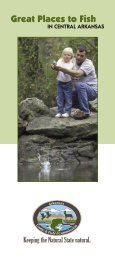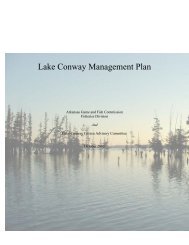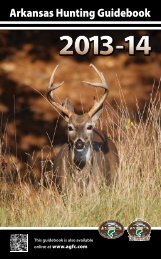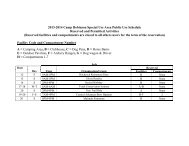View Article - Arkansas Game and Fish Commission
View Article - Arkansas Game and Fish Commission
View Article - Arkansas Game and Fish Commission
- No tags were found...
You also want an ePaper? Increase the reach of your titles
YUMPU automatically turns print PDFs into web optimized ePapers that Google loves.
near the edge. It’s best to wait in one placeor drift slowly along; chasing waterfowl <strong>and</strong>other birds may cause them to take flight.The best advantage of a belly boat blindis the birds’ acceptance of a floating innertube, as opposed to a hidden structure onl<strong>and</strong>. Waterfowl always look toward shorefor signs of danger. By being in the water, aphotographer puts less pressure on flightysubjects <strong>and</strong> catches more images of natureacting naturally.Tips for a safe <strong>and</strong> successfulphotographic outing on water• Carry a change of dry clothes <strong>and</strong>extra gear in a dry bag in cold weather.• Don’t use float tubes in fast water.• Practice launching <strong>and</strong> l<strong>and</strong>ingwithout camera equipment.• Don’t launch in muddy or slipperyareas; a fall could cost you an expensivecamera <strong>and</strong> lens.• Walk backward when launching withfins on.• Don’t use a belly boat in thunderstormsor high winds.2. For the uprights, cut three pieces of halfinchpipe or conduit 20 inches long.(This length works for a person 6 feettall but can be lengthened or shorteneddepending on an individual’s height.)Insert the pipe ends into the tees on thehoops. Drill a hole into each tee throughthe pipe <strong>and</strong> fasten with a nut <strong>and</strong> bolt.This allows framework to be taken apartfor transportation <strong>and</strong> storage.3. Drape camouflage material over thestructure. Fashion openings for thecamera lens in front <strong>and</strong> on the sides.4. For better camera stability, add a woodenshooting platform covering half the tube’stop. Shape a piece of thick plywood intoa 12-inch-wide, U-shaped pattern <strong>and</strong>strap tightly with rope to the tube’s sides.Drill a hole the diameter of a monopodat a 60-degree angle through a 2-by-6-inchblock of wood. Cut the block in halflengthwise. Mount to the plywood usingall-thread <strong>and</strong> wing-nuts. By tightening<strong>and</strong> loosening the wing-nuts, themonopod can be raised <strong>and</strong> lowered toposition the camera.TOP: The addition of a plywood top creates stability for photographers using large lenses.BOTTOM LEFT: Itdoesn’t matter how big the camera lens is – the best images are taken when the photographer is close to thesubject. BOTTOM RIGHT: A redhead drake takes time to stretch right in front of the photographer’s lens.Building the Belly BlindConstructing a floating photographyblind requires few materials: a float tube,two hoops, six ABS plumbing tees, halfinchpipe or conduit, duct tape, several2-inch-long by quarter-inch bolts <strong>and</strong>material with your favorite camouflagepattern.1. Cut one hoop the size of the float tube<strong>and</strong> the other slightly smaller. Slide threeABS tees onto each hoop, spaced evenlyapart, <strong>and</strong> duct tape in place. Securehoop ends back together with tape.NOVEMBER • DECEMBER 2011ARKANSAS WILDLIFE33




